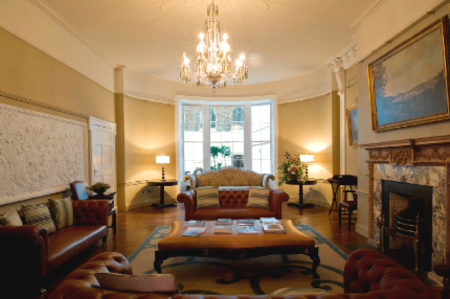
Ciara Kummert explores the National Gallery of Ireland’s little-known gem.
The Friends Room in the National Gallery of Ireland is located at No. 5 South Leinster Street, adjacent to the Gallery. It was built in 1858 and is a neoclassical building. The historical building includes the Office of the Friends of the National Gallery, the main Friends Room, the Orpen Room and an upstairs area, which is used for functions. The Office had many uses before that for hosting the Friends of the National Gallery. Judging by its current condition, one might not expect that the office was once used as a bathroom shop and a furniture display room. The Room functions as a quiet area and Friends are encouraged to visit it for events, tea and coffee or simple perusal, as an escape from the city.
In 2005 renovations began on the Friends Room to incorporate the building into the Millennium Wing of the National Gallery of Ireland to be used by the Friends of the National Gallery. Although it was in a very poor condition, many of its historical features were found to be worth saving. The first recorded owner was Barrister Arthur Wolfe, whose portrait hangs in the Friends Room. Interestingly the second owner was Archibald Hamilton Rowan, leader of the united Irishmen. Both men had starkly contrasting political viewpoints, yet a similar appreciation for aesthetic beauty.
Neoclassical stucco work can be seen in every room on the ceilings.
One of the Friends Rooms notable owners were interior decorators Thomas Panter & Sons, who used the building to display their works. At the time they used the rooms as a showcase. Thomas Panter & Sons’ pieces still make up an important part of the building and are arguably its most beautiful features to this day. Neoclassical stucco work can be seen in every room on the ceilings. The Office also contains a significant amount of neoclassical painted plasterwork. Its ceiling displays grotesque animal forms surrounded by foliage. They recall images of a small-scale ceiling in an ancient Roman church.
The building holds many paintings by the likes of Jack B. Yeats, Frederic William Burton and Hugh Douglas Hamilton.
Between the Friends Room and the Friends Office are two steel pillars which were found in the building’s back yard during its restoration which has been originated from Scotland and were painted white to emulate classical architecture. The bottom of each pillar has an inscription saying ‘W. Farlane and Sons Glasgow’. They have since been incorporated into the structure to support the building. The staircase is not original. It was copied from that of No. 6 next door.
The Friends building was completely separate from the National Gallery until 2002 and did not have a strong correlation with national artwork. However the building holds many paintings by the likes of Jack B. Yeats, Frederic William Burton and Hugh Douglas Hamilton.
Upstairs is a marble fireplace, decorated according to popular Italian style during the building’s first ownership, in the 18th century. One of the images incorporated by the designer into the marble surface is a paintbrush and a paint palette. Before being part of the National Gallery of Ireland this room did not have strong artistic uses. As this building was incorporated into the National Gallery in 2002, the marble fireplace was specially commissioned from a company on Francis street. The fireplaces in both the Friends Office and the Friends Room are not original to the building, they were added in following the restoration which took place in 2008. These were sourced by the Office of Public Works, who took part in the restoration of the building. Hanging high above are chandeliers which were also not part of the original building, but were added during restoration. However, it is the chandeliers upstairs that have perhaps more historical relevance. They originally belonged to No. 89 Merrion square, where the Friends Room was held until the completion of No. 5’s restoration where it would move for its proximity, strong history and impressive aesthetics.
Its rich history makes it a perfect location for the promotion of art and architecture.
In the Orpen Room, downstairs in the Friends building, there are leather chairs whose frames are discreetly decorated with little gold flowers. On the back of every chair reveals small gold tabs. These would have been used by servants to slide two fingers beneath them and pull out the chairs on their wheels. The chairs were originally part of the Milltown collection of Russborough House. It was from the same collection that the two ornamental mirrors hanging upstairs came from.
The Friends Room has had numerous owners and uses. It has been a bathroom shop, a restaurant, a nightclub, a linen warehouse and a furniture display room. Its rich history makes it a perfect location for the promotion of art and architecture through the monthly talks hosted at No. 5. The Friends Room’s history, architectural features and paintings by prolific Irish artists allow viewers a taste of Dublin’s culture throughout the years.
Reblogged this on historyofartandarchitecturestudent.